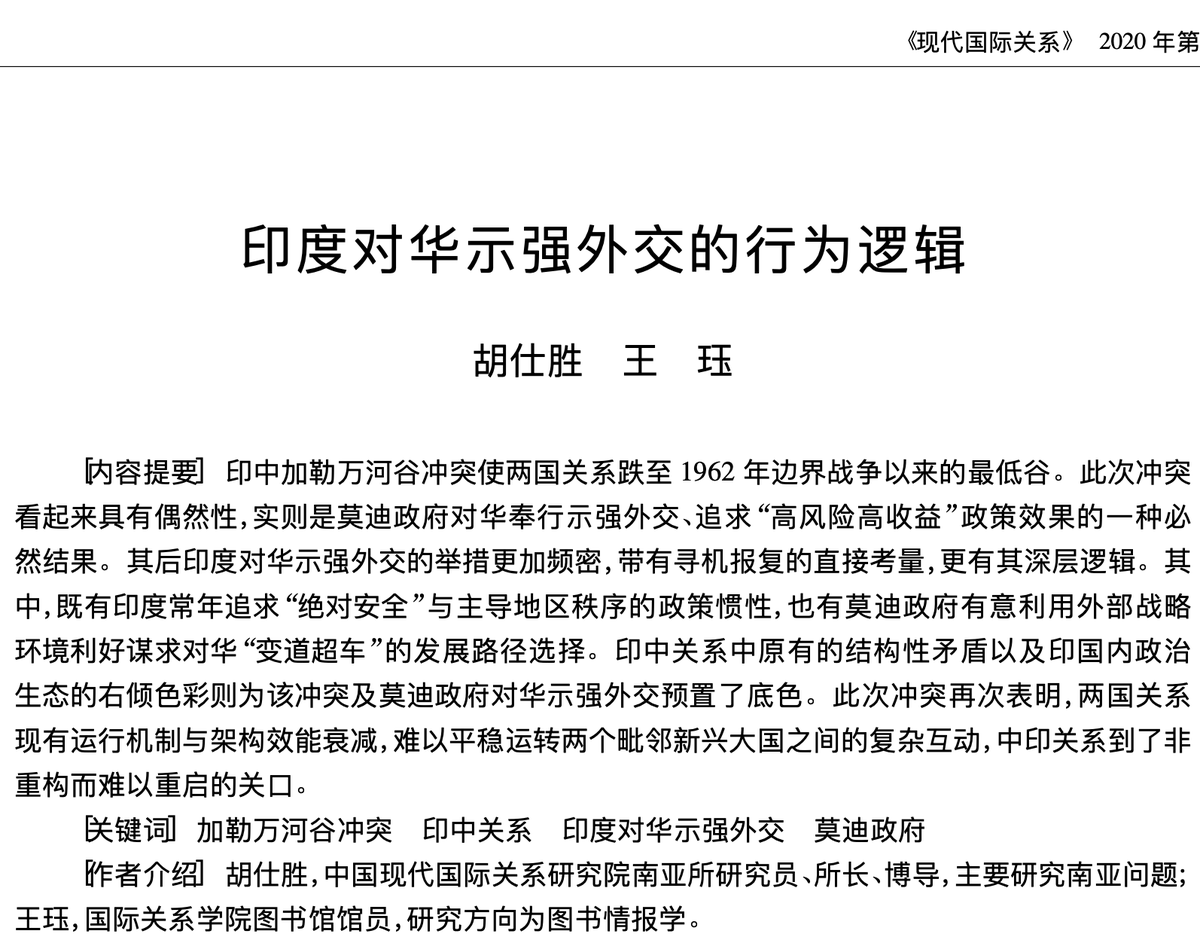A Chinese view on the border clashes with India: thread presenting the key points of a CICIR analysis: “The behavioral logic of India’s tough diplomacy toward China”. Hu Shisheng is a leading expert of South Asia from the Ministry of State Security, his voice carries weight.
The starting point: incidents in the Galwan Valley were accidental and caused by the reclessness of India& #39;s commanding officers - they name Colonel Babu. But "there is necessity in accidents" (偶然中有必然), and a deeper cause: India& #39;s "forward policy" towards the border.
The authors see a continuous Indian policy of "salami slicing" (切香肠) at the border despite India& #39;s defeat in the 1962 war. They accuse India of having crossed the line of actual control 1581 times in 2019, 94% of which on the western sector of the LAC.
They argue that India had an interest to cause an incident in the Galwan Valley because of the Chinese military activities against the Darbuk/Shyok/Daulat Beg Oldie road, which commands India& #39;s military access to the Siachen glacier - so highly strategic.
Hu and Wang generalize these observation to argue that the root cause of the clashes is an illusory "quest for absolute security" by the Indian side 追求“绝对安全”的一种迷思
But there are other factors. One is the "influence of conservative politics". Under Modi, conservative forces have squeezed the living space of the liberal elites among diplomatic and business circles. 保守势力政治上得势后便迅速挤压传统上以外交,商界精英为主的自由派生存空间
The authors also see the clashes as a diversion tactic for the Indian government, in times of huge governance challenges - they even call the Galwan conflict a "life-saving straw to divert attention" (转移视线的救命稻草).
"Make in India" has not been successful so far, the share of the industrial sector in India& #39;s GDP is hovering around 15%, its lowest point in 50 years. Desinicisation is an opportunity but it can only be selective given the dependence of India& #39;s industry on Chinese supplies
They then make an argument regarding the coexistence of two great powers rising at the same time and their competition for regional dominance.
Coexistence between China and India is particularly hard to achieve because after WW2, one newly born country has sought to negate the colonial order, while the other is the successor of the colonial order. 一个新生国家是殖民秩序的否定者,另一个新 生国家是殖民秩序的继承者
The current international environment is favorable to India. The confrontation between the US and China has resulted in a sharp rise of India& #39;s strategic value in the eyes of the US and the West. PM Modi is failing to turn this into an engine of "national rejuvenation" (国家振兴)
but this has fueled a tough foreign policy towards China. By contrast, China& #39;s security environment has severely deteriorated with the rise of an anti-China united front, policies to restructure supply chains and an anti-globalization movement that undermines China& #39;s economy
This contrast reminds the authors of the 1959-1962 international environment. China was trapped by internal disasters and international setbacks (the Sino-Soviet split, crisis with the US). With good relations with both superpowers, India was able to challenge China at the border
China was only able to reverse this dire situation because it could exploit the moment of the Cuba missile crisis. The state of the border is a "vivid reflection of great power geopolitics" 大国地缘博弈的一个强烈折射。
They conclude with the pessimistic assessment that China-India relations have entered a period of high volatility (长波动期). The alternative would be to change course and return to "win-win cooperation" but they don& #39;t offer specific ideas regarding how that could be achieved.
Confrontation takes place in a period of deep change in the international order, and thus the stakes could not be higher. The authors argue that China and India risk missing their strategic opportunity to return to historical glory 那只会断送再创历史辉煌的战略机遇
And just for the incredible image (!!): if the mouths of the population of the two countries could combine in a single one, they would form a bottomless pit with a surface of140 to 150 square kilometers 如果将两国民众的每一张嘴都合成一起,那会是一个 140 ~ 150 平方公里的无底洞。
The piece was published in the July issue of 现代国际关系. The latest developments, including the five points agreed at the Jaishankhar-Wang Yi meeting in Moscow, are obviously not included. It does not analyze China& #39;s own policies and actions. But the focus is more structural.
The above points are obviously all debatable, especially the factual analysis of what led to the clashes. The overall pessimism and the comparison to 1959-1962 are quite striking. Let& #39;s see if it is translated in English and published later by CICIR...

 Read on Twitter
Read on Twitter


